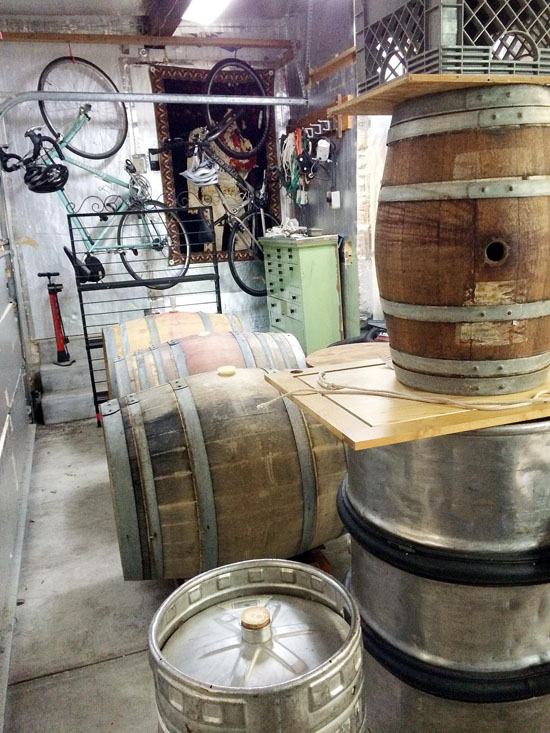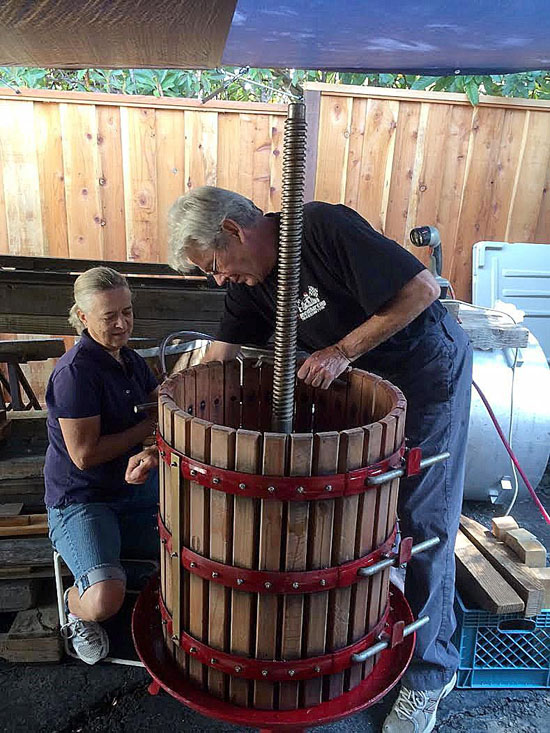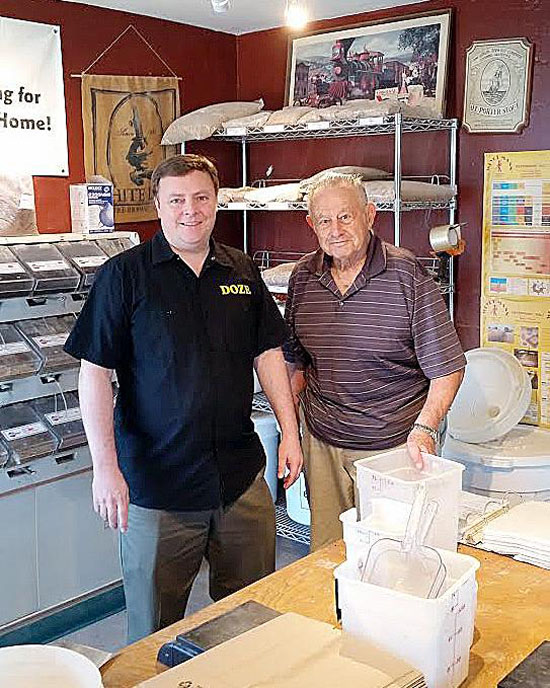 |
|
|
No room for a car in Bill Rose's Lafayette garage, filled with winemaking supplies. Photo Diane Claytor
|
|
|
|
|
|
F or most of us, the garage is where we store our car, old furniture and last year's holiday decorations. But a growing number of Lamorindans have found a much more pleasurable use for their garages: producing adult libations. There's even a word for this fun activity: "garagista."
 Vehicles belonging to longtime Lafayette resident Bill Rose haven't seen the inside of his garage for many years. That space is taken up by his wine-making equipment. Several miles away, Lafayette residents Troy Feddersen and Milt Bruzzone use their garages to house everything they need for brewing beer. And in both cases, friends and neighbors reap the benefits.
Vehicles belonging to longtime Lafayette resident Bill Rose haven't seen the inside of his garage for many years. That space is taken up by his wine-making equipment. Several miles away, Lafayette residents Troy Feddersen and Milt Bruzzone use their garages to house everything they need for brewing beer. And in both cases, friends and neighbors reap the benefits.
 Rose became interested in wine while living in France following his college graduation. Once he moved to Lafayette, he learned that his dentist was a home winemaker and looking for a helper. Rose quickly volunteered to become a "cellar rat" and learned about making wine. "It was pretty rudimentary. We used a six foot diameter redwood hot tub," Rose said. "When it leaked, we used dental wax to stop the leaks. We actually made some pretty decent wine." After several years, Rose and his wife, Beverly, decided they wanted to start making wine on their own. But they also realized they had much more to learn. They took classes in chemistry and winemaking techniques; they learned about grapes, where to get them and how to grow them. And then the fun began.
Rose became interested in wine while living in France following his college graduation. Once he moved to Lafayette, he learned that his dentist was a home winemaker and looking for a helper. Rose quickly volunteered to become a "cellar rat" and learned about making wine. "It was pretty rudimentary. We used a six foot diameter redwood hot tub," Rose said. "When it leaked, we used dental wax to stop the leaks. We actually made some pretty decent wine." After several years, Rose and his wife, Beverly, decided they wanted to start making wine on their own. But they also realized they had much more to learn. They took classes in chemistry and winemaking techniques; they learned about grapes, where to get them and how to grow them. And then the fun began.
 Rose, a retired sales executive, makes both white and red wines and describes himself as a "laissez-faire" winemaker. "I try not to get in the way of the normal process." He's made some excellent wines and admits to having some that weren't very good. "When wine isn't good, it's part of the mystery of winemaking. As someone once advised me, calm down and let the wine do its thing. Have a glass and relax," Rose stated.
Rose, a retired sales executive, makes both white and red wines and describes himself as a "laissez-faire" winemaker. "I try not to get in the way of the normal process." He's made some excellent wines and admits to having some that weren't very good. "When wine isn't good, it's part of the mystery of winemaking. As someone once advised me, calm down and let the wine do its thing. Have a glass and relax," Rose stated.
 He makes 75 to 100 cases of wine a year and does this for his own personal pleasure. "It's a great hobby," Rose proclaimed. "When I was younger, I had a Walter Mitty-type dream of being the next Robert Mondavi. I even looked to see if I could find five acres in Sonoma for a small vineyard. And then I studied the economics of it and realized that it just didn't make sense for me. So I decided not to ruin my hobby by putting dollar signs in front of it. My Super Bowl is when I give my friends a bottle and they tell me it's one of the best wines they've ever had," he noted.
He makes 75 to 100 cases of wine a year and does this for his own personal pleasure. "It's a great hobby," Rose proclaimed. "When I was younger, I had a Walter Mitty-type dream of being the next Robert Mondavi. I even looked to see if I could find five acres in Sonoma for a small vineyard. And then I studied the economics of it and realized that it just didn't make sense for me. So I decided not to ruin my hobby by putting dollar signs in front of it. My Super Bowl is when I give my friends a bottle and they tell me it's one of the best wines they've ever had," he noted.
 Rose is a member of the Contra Costa Wine Group, a 35-year-old organization of "home winemakers dedicated to making and drinking good wine." The group conducts a very professional and popular wine competition every year - last year there were 110 entries - and judges include sommeliers, winery owners, wine retailers and restaurateurs. Rose has won four blue ribbons over the last eight years, an accomplishment of which he's very proud.
Rose is a member of the Contra Costa Wine Group, a 35-year-old organization of "home winemakers dedicated to making and drinking good wine." The group conducts a very professional and popular wine competition every year - last year there were 110 entries - and judges include sommeliers, winery owners, wine retailers and restaurateurs. Rose has won four blue ribbons over the last eight years, an accomplishment of which he's very proud.
 Although Lafayette's Feddersen grew up in Napa, worked in wineries, took winemaking classes and enjoys a good glass of wine, he finds it much more satisfying to make beer. "It's amazing how many people around here make their own beer," Feddersen said. "I've learned that several neighbors and even one of the Lafayette City Council members are home brewers." Bruzzone had long been interested in learning how to make beer. When he met Feddersen at a Lafayette Rotary gathering and tasted Feddersen's home brew, Bruzzone knew he had found his teacher. The two have been brewing together for just over a year. Bruzzone says Feddersen, who has been making beer since his college days, is an excellent teacher.
Although Lafayette's Feddersen grew up in Napa, worked in wineries, took winemaking classes and enjoys a good glass of wine, he finds it much more satisfying to make beer. "It's amazing how many people around here make their own beer," Feddersen said. "I've learned that several neighbors and even one of the Lafayette City Council members are home brewers." Bruzzone had long been interested in learning how to make beer. When he met Feddersen at a Lafayette Rotary gathering and tasted Feddersen's home brew, Bruzzone knew he had found his teacher. The two have been brewing together for just over a year. Bruzzone says Feddersen, who has been making beer since his college days, is an excellent teacher.
 Unlike wine, which, depending on the grape and style, can take anywhere from six months to three years before you have a drinkable product, it can take as little as three weeks from start to finish to get an excellent bottle of beer, Feddersen explained.
Unlike wine, which, depending on the grape and style, can take anywhere from six months to three years before you have a drinkable product, it can take as little as three weeks from start to finish to get an excellent bottle of beer, Feddersen explained.
 "It's also easier to get beer to taste right, and there's a wider range of what's acceptable," he noted. "Beers have their own definite styles and you can tweak them so you can get exactly what you like." People have been known to add ginger or chocolate to their home-brewed beers. "Milt likes honey beer so we've added honey to every batch we've made," Feddersen said.
"It's also easier to get beer to taste right, and there's a wider range of what's acceptable," he noted. "Beers have their own definite styles and you can tweak them so you can get exactly what you like." People have been known to add ginger or chocolate to their home-brewed beers. "Milt likes honey beer so we've added honey to every batch we've made," Feddersen said.
 Both Rose and Feddersen say that temperature control is probably one of the most significant factors in making excellent alcoholic beverages at home. And both admit to being somewhat creative with managing this. Red wine is typically made in the fall "when the evenings can get quite cool," Rose said. So he wraps electric blankets around the vats of wine and regulates the temperature by turning the blanket temperature up or down. With white wine, he runs cold water through stainless steel coils, which he places directly into the wine. Feddersen's temperature control process is very similar; if it's too warm, he puts a towel with ice over the carboy (the container in which the beer ferments) and if it's too cool, he'll wrap the carboy in an electric blanket. "There are heating and cooling solutions you can buy," Feddersen said, "but my methods seem to work just fine."
Both Rose and Feddersen say that temperature control is probably one of the most significant factors in making excellent alcoholic beverages at home. And both admit to being somewhat creative with managing this. Red wine is typically made in the fall "when the evenings can get quite cool," Rose said. So he wraps electric blankets around the vats of wine and regulates the temperature by turning the blanket temperature up or down. With white wine, he runs cold water through stainless steel coils, which he places directly into the wine. Feddersen's temperature control process is very similar; if it's too warm, he puts a towel with ice over the carboy (the container in which the beer ferments) and if it's too cool, he'll wrap the carboy in an electric blanket. "There are heating and cooling solutions you can buy," Feddersen said, "but my methods seem to work just fine."
 Making wine and beer at home is done for the pure enjoyment of both the activity and the results. Feddersen and Rose say that while their hobbies may be somewhat cost-effective, by the time you consider all the equipment and supplies needed, they're not really saving money. "Home brewers are typically making a quality beer," Feddersen noted, "so the price is basically equivalent to what you'd pay in a store."
Making wine and beer at home is done for the pure enjoyment of both the activity and the results. Feddersen and Rose say that while their hobbies may be somewhat cost-effective, by the time you consider all the equipment and supplies needed, they're not really saving money. "Home brewers are typically making a quality beer," Feddersen noted, "so the price is basically equivalent to what you'd pay in a store."
 Bruzzone, Feddersen and Rose all have a real passion for their beer-brewing and wine-making hobbies and love being able to share the resulting bottles with their friends. No doubt, these friends happily accept.
Bruzzone, Feddersen and Rose all have a real passion for their beer-brewing and wine-making hobbies and love being able to share the resulting bottles with their friends. No doubt, these friends happily accept.

|



